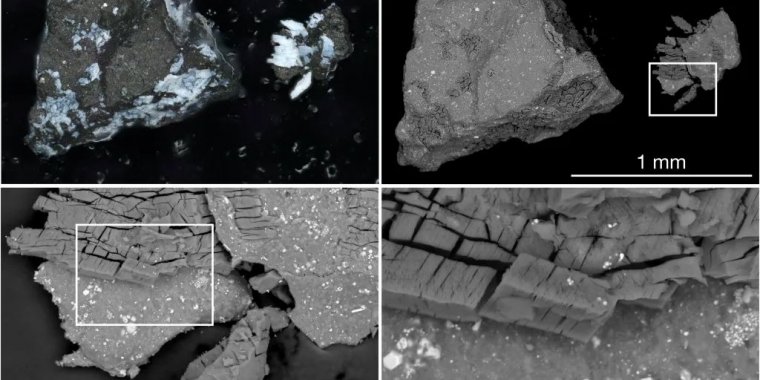| News / Space News |
Surprising Phosphate Finding in NASA’s OSIRIS-REx Asteroid Sample
The OSIRIS-REx Sample Analysis Team found that Bennu contains the original ingredients that formed our solar system.

A tiny fraction of the asteroid Bennu sample returned by NASA’s OSIRIS-REx mission, shown in microscope images. The top-left pane shows a dark Bennu particle, about a millimeter long, with an outer crust of bright phosphate. The other three panels show progressively zoomed-in views of a fragment of the particle that split off along a bright vein containing phosphate, captured by a scanning electron microscope. Photo: Lauretta & Connolly et al. (2024) Meteoritics & Planetary Science, doi:10.1111/maps.14227.
The asteroid’s dust is rich in carbon and nitrogen, as well as organic compounds, all of which are essential components for life as we know it.
The sample also contains magnesium-sodium phosphate, which was a surprise to the research team, because it wasn’t seen in the remote sensing data collected by the spacecraft at Bennu.
Its presence in the sample hints that the asteroid could have splintered off from a long-gone, tiny, primitive ocean world.
Analysis of the Bennu sample unveiled intriguing insights into the asteroid’s composition. Dominated by clay minerals, particularly serpentine, the sample mirrors the type of rock found at mid-ocean ridges on Earth, where material from the mantle, the layer beneath Earth’s crust, encounters water.
This interaction doesn’t just result in clay formation; it also gives rise to a variety of minerals like carbonates, iron oxides, and iron sulfides. But the most unexpected discovery is the presence of water-soluble phosphates. These compounds are components of biochemistry for all known life on Earth today.
While a similar phosphate was found in the asteroid Ryugu sample delivered by JAXA’s (Japan Aerospace Exploration Agency) Hayabusa2 mission in 2020, the magnesium-sodium phosphate detected in the Bennu sample stands out for its purity — that is, the lack of other materials in the mineral — and the size of its grains, unprecedented in any meteorite sample.
The finding of magnesium-sodium phosphates in the Bennu sample raises questions about the geochemical processes that concentrated these elements and provides valuable clues about Bennu’s historic conditions.
“The presence and state of phosphates, along with other elements and compounds on Bennu, suggest a watery past for the asteroid,” said Dante Lauretta, co-lead author of the paper and principal investigator for OSIRIS-REx at the University of Arizona, Tucson. “Bennu potentially could have once been part of a wetter world. Although, this hypothesis requires further investigation.”
“OSIRIS-REx gave us exactly what we hoped: a large pristine asteroid sample rich in nitrogen and carbon from a formerly wet world,” said Jason Dworkin, a co-author on the paper and the OSIRIS-REx project scientist at NASA’s Goddard Space Flight Center in Greenbelt, Maryland.
Despite its possible history of interaction with water, Bennu remains a chemically primitive asteroid, with elemental proportions closely resembling those of the Sun.
“The sample we returned is the largest reservoir of unaltered asteroid material on Earth right now,” said Lauretta.
This composition offers a glimpse into the early days of our solar system, over 4.5 billion years ago. These rocks have retained their original state, having neither melted nor resolidified since their inception, affirming their ancient origins.
The team has confirmed the asteroid is rich in carbon and nitrogen. These elements are crucial in understanding the environments where Bennu’s materials originated and the chemical processes that transformed simple elements into complex molecules, potentially laying the groundwork for life on Earth.
“These findings underscore the importance of collecting and studying material from asteroids like Bennu — especially low-density material that would typically burn up upon entering Earth’s atmosphere,” said Lauretta. “This material holds the key to unraveling the intricate processes of solar system formation and the prebiotic chemistry that could have contributed to life emerging on Earth.” (NASA)
YOU MAY ALSO LIKE





